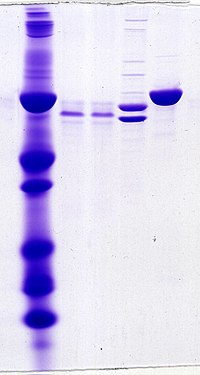
Sulforaphane prevents quinolinic acid‐induced mitochondrial dysfunction in rat striatum
Sign Up to like & getrecommendations! Published in 2017 at "Journal of Biochemical and Molecular Toxicology"
DOI: 10.1002/jbt.21837
Abstract: Quinolinic acid (QA) triggers striatal neuronal death by an excitotoxic cascade that involves oxidative stress, which in turns is tightly linked to mitochondria. Mitochondrial dysfunction is a molecular feature described in several brain pathologies. In… read more here.
Keywords: sulforaphane prevents; dysfunction; quinolinic acid; mitochondrial dysfunction ... See more keywords

Elevated quinolinic acid levels in cerebrospinal fluid in subacute sclerosing panencephalitis
Sign Up to like & getrecommendations! Published in 2020 at "Journal of Neuroimmunology"
DOI: 10.1016/j.jneuroim.2019.577088
Abstract: Subacute sclerosing panencephalitis (SSPE) is a rare neurodegenerative disorder caused by a persistent infection with aberrant measles virus. Indoleamine-2, 3-dioxygenase (IDO) initiates the increased production of kynurenine pathway (KP) metabolites quinolinic acid (QUIN), which has… read more here.
Keywords: cerebrospinal fluid; subacute sclerosing; sclerosing panencephalitis; quinolinic acid ... See more keywords

5,6,7 trihydroxy flavone armoured neurodegeneration caused by Quinolinic acid induced huntington’s like disease in rat striatum - reinstating the level of brain neurotrophins with special reference to cognitive-socio behaviour, biochemical and histopathological aspects
Sign Up to like & getrecommendations! Published in 2021 at "Neuroscience research"
DOI: 10.1016/j.neures.2021.08.003
Abstract: Huntington Disease (HD), a predominant Neurodegenerative Disorder which might be induced by endogenous neurotoxin called Quinolinic Acid (QA), an N-methyl-D aspartate receptor (NMDAR) agonist, the bilaterally intrastriatal administration (200 nm/2 µl of saline) offers rise to the… read more here.
Keywords: huntington; striatum; disease; trihydroxy flavone ... See more keywords

Sustained Activation of JNK Induced by Quinolinic Acid Alters the BDNF/TrkB Axis in the Rat Striatum
Sign Up to like & getrecommendations! Published in 2018 at "Neuroscience"
DOI: 10.1016/j.neuroscience.2018.04.034
Abstract: Oxidative stress secondary to excitotoxicity is a common factor in the physiopathology of a variety of neurological disorders. In response to oxidative stress, several signaling pathways, such as MAPK, are activated or inactivated. Mitogen-activated protein… read more here.
Keywords: jnk; quin; bdnf trkb; induced quinolinic ... See more keywords

Behavioral activation therapy for depression is associated with a reduction in the concentration of circulating quinolinic acid.
Sign Up to like & getrecommendations! Published in 2020 at "Psychological medicine"
DOI: 10.1017/s0033291720004389
Abstract: BACKGROUND An inflammation-induced imbalance in the kynurenine pathway (KP) has been reported in major depressive disorder but the utility of these metabolites as predictive or therapeutic biomarkers of behavioral activation (BA) therapy is unknown. METHODS… read more here.
Keywords: depression; behavioral activation; activation therapy; therapy ... See more keywords

Samarium-Based Turn-Off Fluorescence Sensor for Sensitive and Selective Detection of Quinolinic Acid in Human Urine and Serum.
Sign Up to like & getrecommendations! Published in 2022 at "Inorganic chemistry"
DOI: 10.1021/acs.inorgchem.2c03926
Abstract: Quinolinic acid (QA) is an index for some diseases, whose detection is of importance. This work presents a samarium metal-organic framework (Sm-MOF) containing 5-sulfoisophthalate ligand (SIP3-). The fluorescence of Sm-MOF integrates the emission at 339… read more here.
Keywords: mof; detection; turn fluorescence; fluorescence ... See more keywords

Biodegradation of Quinolinic acid by a Newly Isolated Bacterium Alcaligenes faecalis Strain JQ191.
Sign Up to like & getrecommendations! Published in 2022 at "FEMS microbiology letters"
DOI: 10.1093/femsle/fnac040
Abstract: Quinolinic acid (QA) is a pyridine derivative that can be found in many organisms and is widely used in the chemical industry. However, QA possesses excitotoxic properties. To date, the catabolism of QA mediated by… read more here.
Keywords: strain jq191; jq191; alcaligenes faecalis; quinolinic acid ... See more keywords

Quinolinic acid induces neuritogenesis in SH‐SY5Y neuroblastoma cells independently of NMDA receptor activation
Sign Up to like & getrecommendations! Published in 2017 at "European Journal of Neuroscience"
DOI: 10.1111/ejn.13499
Abstract: Glutamate and nicotinamide adenine dinucleotide (NAD+) have been implicated in neuronal development and several types of cancer. The kynurenine pathway of tryptophan metabolism includes quinolinic acid (QA) which is both a selective agonist at N‐methyl‐D‐aspartate… read more here.
Keywords: acid induces; nmda receptors; independently nmda; induces neuritogenesis ... See more keywords

Cloning and functional characterization of quinolinic acid phosphoribosyl transferase (QPT) gene of Nicotiana tabacum.
Sign Up to like & getrecommendations! Published in 2017 at "Physiologia plantarum"
DOI: 10.1111/ppl.12559
Abstract: The quinolinate phosphoribosyl transferase (QPT) is a key enzyme that converts quinolinic acid into nicotinic acid mononucleotide. The QPT gene plays an essential role in the pyridine nucleotide cycle as well as in the biosynthetic… read more here.
Keywords: qpt gene; transferase qpt; phosphoribosyl transferase; acid ... See more keywords

Central Nervous System Infection with Borna Disease Virus Causes Kynurenine Pathway Dysregulation and Neurotoxic Quinolinic Acid Production
Sign Up to like & getrecommendations! Published in 2017 at "Journal of Virology"
DOI: 10.1128/jvi.00673-17
Abstract: ABSTRACT Central nervous system infection of neonatal and adult rats with Borna disease virus (BDV) results in neuronal destruction and behavioral abnormalities with differential immune-mediated involvement. Neuroactive metabolites generated from the kynurenine pathway of tryptophan… read more here.
Keywords: expression; infection; kynurenine pathway; quinolinic acid ... See more keywords

Neuroprotective Effects of a Wnt Antagonist in Quinolinic Acid-Induced Excitotoxicity in N18D3 Cells.
Sign Up to like & getrecommendations! Published in 2022 at "Cellular and molecular biology"
DOI: 10.14715/cmb/2022.68.8.30
Abstract: Excessive stimulation of the quinolinic acid induces neuronal cell death and is implicated in developing several neurodegenerative diseases. This study investigated whether a Wnt5a antagonist plays a neuroprotective role by regulating the Wnt pathway, activating… read more here.
Keywords: cell; neuroprotective effects; death; acid ... See more keywords